Comments: In this study, researchers looked for a link between ED and indices of pornography addiction using “craving” questionnaires. While no such link turned up (perhaps because users don’t accurately assess their degree of “craving” until they attempt to quit using), some other interesting correlations appeared in their results:
Rates of erectile dysfunction were lowest in those [men] preferring partnered sex without pornography (22.3%) and increased significantly when pornography was preferred over partnered sex (78%).
…Those [men] who used on an almost daily basis or more had ED rates of 44% (12/27) compared to 22% (47/213) for those more “casual” users (≤5x/week), reaching significance on univariate analysis (p=0.017). It may be that volume does play a role to some extent
Also, as the authors point out,
The proposed pathophysiology of PIED seems plausible and is based on a variety of researchers work and not a small collection of researchers that might be swayed by an ethical bias. Also supporting the “causation” side of the argument are reports of men regaining normal sexual function after discontinuation of excessive pornography use.
Only prospective studies will be able to definitively solve the question of causation or association, including interventional studies evaluating the success of abstention in treating ED in heavy pornography users.
Abstract
Military Medicine, usz079, https://doi.org/10.1093/milmed/usz079 Published: 24 April 2019
Jonathan H Berger, MC USN John E Kehoe, MC USN Andrew P Doan, MC USN Donald S Crain, MC USN Warren P Klam, MC USN Michael T Marshall, MC USN Matthew S Christman, CDR MC USN
Introduction
We aimed to explore and describe the pornography habits of young men and women. Given recent upward trends in pornography use and erectile dysfunction, along with a plausible pathophysiology, we hypothesized that pornography use would correlate with sexual dysfunction.
Materials and Methods
Institutional Review Board approval was obtained. Surveys were distributed to 20–40 year old men and women presenting to a urology clinic. Information was collected on demographics and medical history. Sexual function was evaluated with the International Index of Erectile Function (IIEF) in men and the Female Sexual Function Index in women. Extent of potential addiction to pornography was measured with the pornography craving questionnaire and the obsessive passion scale. Pornography use was measured based on both frequency and duration, and analyzed relative to sexual dysfunction.
Results
Men used pornography significantly more frequently than women (81.1% vs. 39%). Computer and cellular phone image viewing were the most popular modalities in both sexes. There was no association between IIEF and craving for, or obsessive passion for, pornography. Preference for pornography with masturbation was found to be significantly associated with erectile dysfunction (p = 0.001). Rates of erectile dysfunction were lowest in those preferring partnered sex without pornography (22.3%) and increased significantly when pornography was preferred over partnered sex (78%). No correlation was found between any variables and female sexual dysfunction.
Conclusions
Pornography and sexual dysfunction are common among young people. No clear relationship exists between extent of addiction to pornography and sexual dysfunction in either gender. However, men who prefer masturbation with pornography to partnered sex have a significantly increased risk of sexual dysfunction. Given sexual dysfunction may be associated with mental health concerns, further evaluation of its causes and impact on military operational readiness are warranted.
